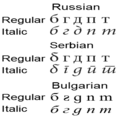Unicode facts for kids
Unicode is like a secret codebook that helps computers understand and show text from almost every language in the world! Imagine trying to read a book where every letter looks different depending on which country it came from – that would be super confusing! Unicode solves this problem by giving every single letter, number, and symbol a special, unique number. This way, computers everywhere can understand and display text correctly, no matter if it's English, Chinese, Arabic, or any other language.
It was created in the 1990s by a group called the Unicode Consortium. Their big goal was to make one worldwide standard for all languages, replacing many older, different codes. New versions of Unicode come out every few years, and the latest ones have over 100,000 different characters!
Unicode doesn't just include letters and numbers you can print. It also has special characters that tell the computer how to arrange text. For example, there's a Unicode character that tells the computer to start a new line, or another that tells it to write text from right to left (like in Arabic).
Every character in Unicode, like the letter 'é', has a special number called a "code point." These code points are then turned into "code units," which are like small digital packets of information (8, 16, or 32 bits). This is how computers can store and use all these characters.
How Computers Use Unicode
Computers need a way to turn these special Unicode numbers into something they can actually store and send. This is called "encoding." Think of it like packing the code points into different-sized boxes. There are a few main ways to do this:
- UTF-7: This is an older way that uses 7 bits for each character. It's not very popular anymore and isn't officially part of the main Unicode standard.
- UTF-8: This is the most common way to encode Unicode! It uses 8 bits for each character, but it's clever because it can use more bits for more complex characters. It's also compatible with an older code called ASCII, which is why it's so widely used. Many common characters can be stored using just 2 bytes.
- UTF-16: This method uses 16 bits for each character. Like UTF-8, it can also use more bits if needed for very complex characters.
- UTF-32: This is the simplest way, as it uses 32 bits for every single character. This means every character takes up the same amount of space.
UTF-8 is super popular for sharing information online, like on the internet and in emails. Many computer programs, like those written in Java, also use a version of UTF-8.
Why Unicode is Important
Before Unicode, if you sent a message to someone who had a different computer or used a different language setting, your message might look like gibberish! Unicode helps make sure that when you type something, it looks the same for everyone, everywhere. It helps computers talk to each other about text without getting confused.
Sometimes, even with Unicode, there can be small challenges. For example, some languages have very specific ways their letters connect or change shape. For these special cases, other technologies like OpenType help make sure everything looks perfect.
Images for kids
See also
 In Spanish: Unicode para niños
In Spanish: Unicode para niños


